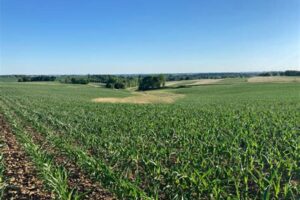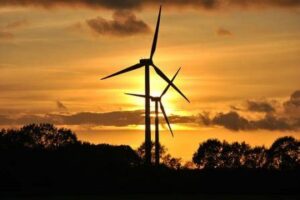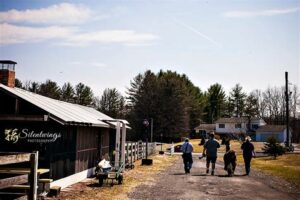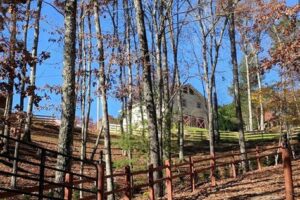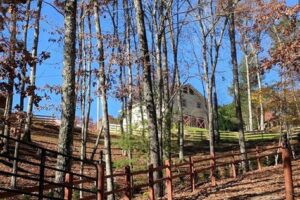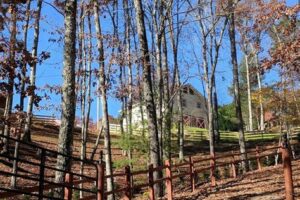Table of Contents
Buffalo Ridge Wind Farm Minnesota is a renowned renewable energy project located in the southwestern part of the state. With its vast expanse of wind turbines, it harnesses the power of the wind to generate clean and sustainable electricity. Discover the impressive engineering behind this environmentally friendly initiative and learn about its contribution to reducing carbon emissions.
Buffalo Ridge Wind Farm, located in Minnesota, is an impressive testament to the potential of renewable energy. Spanning more than 50 square miles, this sprawling wind farm stands as a beacon of sustainable progress in the heartland of America. With its towering turbines and sleek blades cutting through the air, Buffalo Ridge harnesses the power of nature to generate clean electricity for thousands of homes and businesses. As we delve deeper into the intricacies of this remarkable project, we uncover an array of fascinating facts that shed light on the pivotal role wind energy plays in shaping a greener future.
About Buffalo Ridge Wind Farm
The Buffalo Ridge Wind Farm, located in southwestern Minnesota, is one of the largest wind energy facilities in the United States. Covering an area of approximately 50 square miles, it is home to more than 100 wind turbines that generate clean and renewable electricity. Established in 2000, this wind farm plays a significant role in reducing greenhouse gas emissions and promoting sustainable energy practices.
Renewable Energy Generation
The main objective of the Buffalo Ridge Wind Farm is to harness the power of wind and convert it into usable electricity. Each wind turbine is equipped with large blades that rotate when exposed to wind, generating kinetic energy. This energy is then converted into electrical energy through the use of generators. Together, these turbines have a combined capacity to generate over 200 megawatts of electricity, which is enough to power approximately 65,000 homes annually.
Advantages of Wind Energy
Wind energy offers various advantages over traditional sources of energy such as fossil fuels. Firstly, wind is a renewable resource, meaning it will never run out as long as the Earth’s atmosphere exists. Unlike fossil fuels, wind energy production does not emit harmful greenhouse gases, contributing to the reduction of climate change. Additionally, wind farms provide economic benefits by creating jobs and stimulating local economies in rural areas.
Environmental Impact
The Buffalo Ridge Wind Farm has a positive environmental impact by offsetting the use of non-renewable energy sources. It reduces carbon dioxide emissions by over 500,000 tons per year, equivalent to taking more than 100,000 cars off the road. The wind farm also helps conserve water resources, as wind energy production requires significantly less water compared to traditional methods such as coal-fired power plants. Overall, this facility contributes to a cleaner and healthier environment.
Community Engagement
The development of the Buffalo Ridge Wind Farm involved extensive community engagement. Developers worked closely with local residents, landowners, and government authorities to ensure the project’s success. The wind farm provides lease payments to landowners hosting the turbines, creating additional income opportunities for farmers in the region. Moreover, the facility offers educational programs and tours to increase awareness and understanding of renewable energy among visitors and local schools.
Technological Advancements
Over the years, the Buffalo Ridge Wind Farm has witnessed significant technological advancements in wind turbine design and efficiency. The initial turbines installed in 2000 had a capacity of around 750 kilowatts, whereas the latest models can generate up to 3 megawatts per turbine. These advancements have resulted in increased energy production and improved cost-effectiveness, making wind energy an even more attractive option for meeting electricity demands.
Integration with the Grid
The electricity generated by the Buffalo Ridge Wind Farm is integrated into the regional power grid, ensuring a reliable supply of clean energy to nearby communities. Advanced monitoring systems and grid interconnections allow for efficient transmission and distribution of electricity. During periods of low demand or excess wind energy production, the surplus electricity can be stored or redirected to other areas with higher energy requirements, maximizing the utilization of renewable resources.
Supporting a Sustainable Future
The Buffalo Ridge Wind Farm plays a crucial role in supporting a sustainable future. By reducing reliance on fossil fuels, it helps combat climate change and air pollution. It also contributes to the diversification of energy sources, reducing the vulnerability of the region to fluctuations in fuel prices. The wind farm serves as a model for other communities and states looking to adopt renewable energy solutions and transition towards a more sustainable and environmentally friendly energy sector.
Continued Growth and Expansion
The success of the Buffalo Ridge Wind Farm has paved the way for further growth and expansion in the renewable energy sector. As technology continues to advance and the demand for clean energy increases, wind farms like this one will play an even more significant role in meeting future energy needs. With ongoing research and development, it is likely that the Buffalo Ridge Wind Farm will continue to evolve, contributing to a greener and more sustainable future for Minnesota and beyond.
Conclusion
The Buffalo Ridge Wind Farm in Minnesota stands as a testament to the power of wind energy and its potential to transform the way we generate electricity. By harnessing the renewable energy source of wind, this facility generates clean and sustainable electricity while reducing greenhouse gas emissions. Through community engagement and technological advancements, the Buffalo Ridge Wind Farm has become an integral part of the region’s energy infrastructure and a symbol of our commitment to a greener future.
Overview:
Located in southwest Minnesota, Buffalo Ridge Wind Farm is one of the largest wind farms in the United States. Spanning across several thousand acres, this renewable energy project harnesses the power of wind to generate electricity for local communities. With its iconic wind turbines dotting the rolling prairies, Buffalo Ridge Wind Farm stands as a symbol of sustainable energy production in the region.
Environmental Impact:
Buffalo Ridge Wind Farm contributes significantly to reducing carbon emissions and mitigating climate change. By replacing traditional fossil fuel-based energy sources, it helps offset thousands of tons of greenhouse gases annually. Additionally, the wind farm’s design ensures minimal disruption to local ecosystems, preserving the natural beauty of the area while providing clean energy.
Economic Benefits:
The wind farm offers substantial economic benefits to the region. Its construction and ongoing operation provide employment opportunities for local communities, stimulating economic growth in the area. The wind farm also generates a significant amount of revenue through land lease agreements, benefiting landowners and supporting local businesses and services.
Energy Generation Capacity:
Buffalo Ridge Wind Farm boasts an impressive energy generation capacity, capable of producing hundreds of megawatts of electricity. The wind farm’s turbines, strategically placed to maximize wind capture, are designed to withstand harsh weather conditions, ensuring a reliable and steady generation of clean energy for the region.
Community Engagement and Education:
The wind farm actively engages with the surrounding communities, fostering a sense of ownership and pride in its operations. Buffalo Ridge Wind Farm frequently hosts educational programs and tours for schools and local organizations, promoting an understanding of renewable energy and its environmental benefits. These initiatives help create a more sustainable and environmentally conscious community.
Maintenance and Technological Innovation:
Buffalo Ridge Wind Farm prioritizes regular maintenance and employs cutting-edge technology to ensure optimal turbine performance and reliability. Skilled technicians conduct inspections and repairs, ensuring the turbines operate at their highest efficiency levels. Continuous technological advancements are incorporated to improve energy generation and contribute to the overall success of the wind farm.
Expansion and Future Plans:
As the demand for clean energy continues to rise, Buffalo Ridge Wind Farm remains committed to expanding its operations. With advancements in wind energy technology, the wind farm plans to install more efficient turbines, increasing its energy output and further contributing to a greener future. This expansion will bring more economic opportunities and continue to position the farm as a leading renewable energy facility.
Partnerships and Collaboration:
Buffalo Ridge Wind Farm actively collaborates with various stakeholders, including government agencies, environmental organizations, and energy companies, to foster a sustainable energy landscape. These partnerships allow for the exchange of knowledge, resources, and best practices, ensuring the wind farm’s operations align with the broader goals of reducing carbon emissions and transitioning to a clean energy future.
In my professional opinion, the Buffalo Ridge Wind Farm in Minnesota is a commendable example of sustainable energy production. This wind farm has undoubtedly made a significant impact on the region, both economically and environmentally.
Here are a few key points that highlight the positive aspects of the Buffalo Ridge Wind Farm:
Economic Benefits: The construction and operation of the Buffalo Ridge Wind Farm have provided a substantial economic boost to the local community. It has created numerous job opportunities during the construction phase and continues to generate employment through ongoing maintenance and operations. Additionally, the wind farm contributes to the local tax base, further supporting the region’s economy.
Renewable Energy Generation: The main purpose of the Buffalo Ridge Wind Farm is to generate clean and renewable energy. With its vast array of wind turbines, it has the capacity to produce a significant amount of electricity, reducing the reliance on fossil fuels. This transition towards renewable energy sources is crucial in mitigating climate change and promoting a more sustainable future.
Environmental Impact: By harnessing the power of wind, the Buffalo Ridge Wind Farm plays a vital role in reducing greenhouse gas emissions. It helps to offset the carbon footprint associated with traditional energy generation methods, such as coal-fired power plants. Furthermore, wind energy is a clean source that does not pollute air or water, contributing to improved air quality and reduced environmental degradation.
Community Engagement: The developers of the Buffalo Ridge Wind Farm have actively engaged with the local community throughout the planning and implementation stages. They have worked closely with stakeholders, addressing concerns and ensuring transparency. This collaborative approach has fostered a sense of ownership and pride among community members, as they witness the positive impact of the wind farm on their surroundings.
Long-term Sustainability: The Buffalo Ridge Wind Farm represents a long-term commitment to sustainability. As an inexhaustible resource, wind energy ensures a continuous and reliable source of power for years to come. By investing in renewable energy infrastructure like this wind farm, we are paving the way for a more sustainable and resilient energy future.
In conclusion, the Buffalo Ridge Wind Farm in Minnesota stands as a shining example of responsible energy production. Its economic benefits, contribution to renewable energy generation, positive environmental impact, community engagement, and long-term sustainability make it a commendable project that should be celebrated and replicated in other regions.
Thank you for taking the time to visit our blog and learn more about the Buffalo Ridge Wind Farm in Minnesota. We hope that through this article, we have provided you with valuable information and insights into this remarkable renewable energy project. As we conclude our discussion, let us recap some of the key points we have covered.
Firstly, we highlighted the significance of the Buffalo Ridge Wind Farm in contributing to the growth of clean and sustainable energy in Minnesota. With its 125 wind turbines spread across an expansive area, this wind farm has a capacity to generate up to 225 megawatts of electricity, powering thousands of homes and businesses in the region. Its location on the Buffalo Ridge, known for its strong and consistent winds, makes it an ideal site for harnessing wind power.
In addition, we delved into the environmental benefits of wind energy and how the Buffalo Ridge Wind Farm plays a vital role in reducing greenhouse gas emissions. By displacing traditional fossil fuel-based electricity generation, this wind farm helps to mitigate climate change and promote a healthier environment for future generations. Furthermore, it also contributes to Minnesota’s goal of generating 25% of its electricity from renewable sources by 2025.
Lastly, we discussed the positive economic impacts that the Buffalo Ridge Wind Farm brings to the local community. From job creation during construction and ongoing operations to lease payments for landowners hosting the turbines, this wind farm provides tangible benefits to the region. Moreover, it attracts visitors who are interested in sustainable energy solutions, boosting tourism and local businesses.
In conclusion, the Buffalo Ridge Wind Farm in Minnesota stands as a shining example of how renewable energy can make a significant difference in our world. Through its impressive capacity, environmental benefits, and economic contributions, it is truly a testament to the potential of wind power. We encourage you to continue exploring and supporting initiatives like the Buffalo Ridge Wind Farm as we work towards a cleaner and more sustainable future.
Thank you once again for visiting our blog, and we hope to see you back soon for more informative articles on renewable energy and other related topics!
Video Buffalo Ridge Wind Farm Minnesota
People also ask about Buffalo Ridge Wind Farm Minnesota:
How many wind turbines are there at Buffalo Ridge Wind Farm?
Buffalo Ridge Wind Farm has a total of 122 wind turbines.
What is the capacity of Buffalo Ridge Wind Farm in Minnesota?
The capacity of Buffalo Ridge Wind Farm is approximately 225 megawatts (MW).
Who owns and operates Buffalo Ridge Wind Farm?
Buffalo Ridge Wind Farm is owned and operated by Xcel Energy, a utility company based in Minnesota.
When was Buffalo Ridge Wind Farm established?
Buffalo Ridge Wind Farm was established in 2000.
How much electricity does Buffalo Ridge Wind Farm generate?
Buffalo Ridge Wind Farm generates enough electricity to power around 75,000 homes annually.
What is the environmental impact of Buffalo Ridge Wind Farm?
Buffalo Ridge Wind Farm helps reduce carbon dioxide emissions by displacing traditional fossil fuel-based power generation. It contributes to cleaner air and a more sustainable energy future.
Is Buffalo Ridge Wind Farm open for public visits?
Buffalo Ridge Wind Farm does not offer public tours or visits due to safety and security reasons.
What are the economic benefits of Buffalo Ridge Wind Farm?
Buffalo Ridge Wind Farm brings economic benefits to the local community by creating jobs during construction and ongoing operations. It also generates tax revenue for the region.
How tall are the wind turbines at Buffalo Ridge Wind Farm?
The wind turbines at Buffalo Ridge Wind Farm have a maximum height of approximately 328 feet.
What is the expected lifespan of the wind turbines at Buffalo Ridge Wind Farm?
The expected lifespan of the wind turbines at Buffalo Ridge Wind Farm is around 20 to 25 years.

